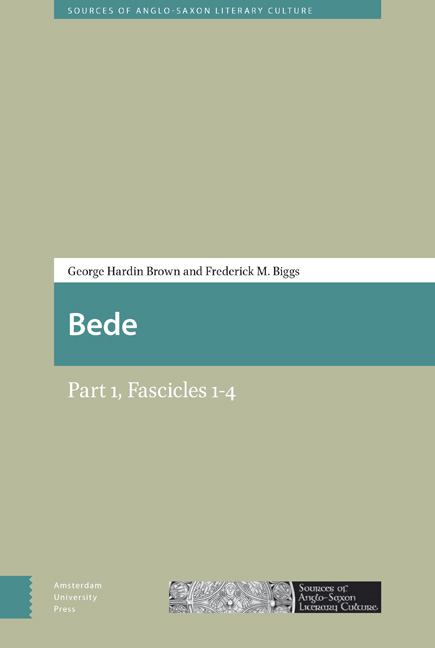Educational Works
Published online by Cambridge University Press: 02 February 2021
Summary
Following his verse compositions in his list of works in book 5, chapter 24 of the HISTORIA ECCLESIASTICA GENTIS ANGLORUM(ed. Lapidge 2010 2.484; trans. Colgrave and Mynors 1969 p 571), Bede itemised five of the works considered in this section:
Two books, one on the nature of things and the other on chronology: also a longer book on chronology.
A book about orthography, arranged according to the order of the alphabet.
A book on the art of metre, and to this is added another small book on figures of speech with which the holy Scriptures are adorned.
Because these books conclude the list, one might assume that they were indeed low in Bede's own relative estimation of his writings, perhaps youthful work that then gave way to what he considered his more serious projects, such as the BIBLICAL COMMENTARIESor HISTORIES. Recent scholarship, however, has challenged this assumption, showing that the subjects addressed in them occupied Bede's interest across his career. Two, DE TEMPORIBUSand DE NATURA RERUM, are almost certainly early, and yet by 703, the likely date of De temporibus, Bede was around thirty years old, and so more than capable of putting the systematic reading that must have occupied his actual youth to good use in his own writings. That he revised De temporibus as DE TEMPORUM RATIONEin 725 confirms his sustained interest in its subject. Similarly, his MAGNUS CIRCULUS SEU TABULA PASCHALIS ANNIS DOMINI DXXXII AD MLXIII, a Paschal table that carried the calculations of DIONYSIUS EXIGUUSinto the eleventh century, could have been written at any point in his career. Moreover, DE ARTE METRICA, DE SCHEMATIBUS ET TROPIS, and DE ORTHOGRAPHIAare all now considered works of Bede's so-called “mature” period. They are, nonetheless, gathered here – in alphabetical order – under the rubric “educational works” because they were probably intended to be used in teaching. Two additional works considered in this section (even though Bede did not mention them in his list of works in the Historia ecclesiastica ), the KALENDARIUM AD USUM COMPUTANDIand the PAGINA REGULARUM, were composed as aids for users of De temporum ratione, and almost certainly played a role in the classroom. As Bede himself wrote, “it has always been my delight to learn or to teach or to write” (ed. 2.480; trans. p 567; emphasis added).
- Type
- Chapter
- Information
- BedePart 1, Fascicles 1-4, pp. 39 - 122Publisher: Amsterdam University PressPrint publication year: 2017



